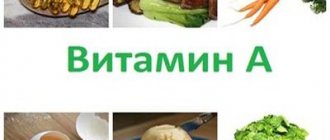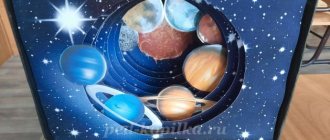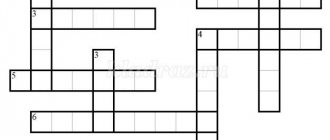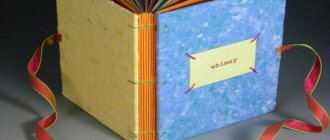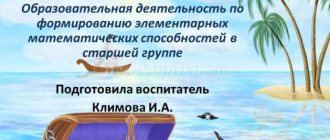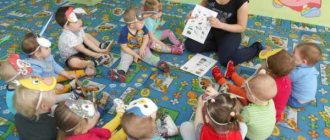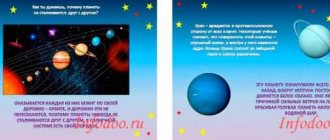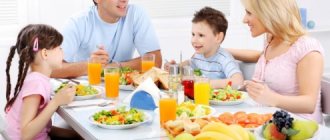Quiz “Vitamins are our friends”
Municipal budgetary preschool educational institution combined type kindergarten No. 7 “Fairy Tale” in the village of Mostovsky municipal formation Mostovsky district
project
"Vitamins are our friends"
Project type:
— According to the dominant activity in the project: cognitive - creative
-By the number of project participants: group (children, parents, teachers)
-By the nature of contacts: among children of the same group.
-By time: short-term (October).
Applicant: children of different age groups
Objective of the project:
To form in children ideas about proper nutrition and a healthy lifestyle.
Tasks:
Introduce the concept of “vitamins” and their role in human life.
Establish the relationship that health depends on proper nutrition (food should be not only tasty, but also healthy)
To clarify and enrich the knowledge of children and parents about the benefits of vitamins, how vitamins affect the human body.
To promote the creation of an active position of parents in the desire to eat healthy foods.
Clarification of concepts: “Fruits”, “Vegetables”, “Berry”. Develop the ability to generalize based on essential features.
To develop in children ideas about the benefits of vegetables, fruits, and berries for human health.
Develop ideas about vitamins and a healthy lifestyle.
Problems:
1. Doctor Aibolit comes to the children and says: “There is a flu in the city and in order not to get sick you need to take enough vitamins. What do you think vitamins are and where do they “live”?”
Problem situation:
– What are vitamins? What products contain them? How can vitamins help you avoid getting sick?
Children set themselves the task: Find out more about vitamins, collect material...
2. Activate the cognitive and speech activity of children through the integration of educational areas.
3. Ignorance by parents about the quantity, quality, variety of products, timeliness and regularity of intake is an important factor in preserving and strengthening the health of children.
Relevance of the project:
The most pressing problem today is strengthening the health of children. V. A. Sukhomlinsky wrote: “I am not afraid to repeat again and again: caring for the health of a child is the most important work of a teacher.” Health is considered as complete physical, mental and social well-being, as a harmonious state of the body, which allows a person to be active in his life and achieve success in various activities. Deterioration in the quality of nutrition and lack of vitamins and microelements in food negatively affect the physical development of children. To achieve harmony with nature, you need to learn to take care of your health from childhood. It is in childhood that the foundations for a healthy organization of a child’s life for the future are laid. Therefore, it is so important to give children an idea about vitamins, their benefits for human health, and the content of certain vitamins in vegetables and fruits.
Quiz on the topic: “Vitamins” (with answers)
1. What vitamin helps maintain the beauty of the skin: a) B7 + b) D c) C
2. Name the first artificially synthesized vitamin: a) E b) B1 + c) A1
3. Which foods contain the most vitamin K: a) Tomatoes b) Beets c) Green leafy vegetables +
4. What natural way allows a person to get all the necessary vitamins: a) A varied diet + b) Regular walks c) Ice skating
5. Which vitamin is responsible for blood clotting: a) Vitamin B12 b) Vitamin A c) Vitamin K +
6. What are the names of special preparations that contain several vitamins in their composition: a) Microelements b) Multivitamins + c) Polypropylenes
7. Due to a lack of which vitamin in the human body, the “Beri-beri” disease occurs: a) C b) A c) B1 +
8. In ancient times, sailors often suffered from scurvy, a disease caused by a lack of vitamin. What vitamin did they lack during sea voyages: a) Vitamin C + b) Vitamin E c) Vitamin A1
9. How many vitamins are known to humanity today: a) About 35 b) About 40 c) About 20 +
10. What is the state of lack of vitamins in the body called: a) Hypervitaminosis b) Hypovitaminosis + c) Vitamin deficiency
11. Which vegetable contains a lot of vitamin A: a) Carrots + b) Potatoes c) Onions
12. Which group of vitamins promotes hair growth: a) C b) B + c) A
13. What is a vitamin according to the definition of Ozhegov’s dictionary: a) An organic substance necessary for the normal functioning of the body, as well as a preparation containing such substances + b) A low molecular weight compound necessary for the body c) A nitrogenous substance contained in food
14. The word “vitamin” comes from the Latin word: a) “vin” b) “vimin” c) “vita” +
15. In what year did Dr. Glen King establish the chemical structure of vitamin C: a) B 1923 + b) B 1935 c) B 1940
16. Which vitamin was the first to be discovered and studied: a) E b) C + c) A
17. What vitamin is necessary for good vision: a) E b) B c) A +
18. What vitamins are included in the popular product “Revit”, also known as ascorbic acid: a) C, E b) A, B1, B2, C + c) C, D
19. From what Latin word does the word “vitamin” come: a) Disease b) Organism c) Life +
20. What vitamin is contained in large quantities in sunflower oil: a) And b) E + c) C
21. What is “tocopherol”: a) Vitamin E + b) Algae c) State of vitamin deficiency
22. Which foods contain the maximum amount of vitamins: a) Porridge b) Fresh vegetables + c) Boiled vegetables
23. What vegetables should you eat to get vitamin K into your body: a) Tomatoes b) Radish c) Cabbage +
24. What is the chemical name of vitamin B2: a) Ascorbic acid b) Riboflavin + c) Aspirin
25. What is another name for vitamin E, showing its effect on the body: a) Natural energy b) Sleep vitamin c) Vitamin of youth +
26. Which well-known weed contains a large amount of vitamin C: a) Burdock b) Nettle + c) Dandelion
27. A substance called beta-carotene is converted into vitamin A, which is good for vision. Which product contains a lot of beta-carotene: a) Carrots + b) Lemon c) Beets
28. Which vitamin is called folic acid: a) C b) A c) B9 +
29. During the siege of Leningrad, the townspeople brewed tea, which made it possible to replenish the lack of vitamin C in conditions of famine. What kind of tea was it: a) From pine needles + b) From birch bark c) From chamomile flowers
30. What are the names of substances that suppress the action of vitamins: a) Nutrients b) Antivitamins + c) Non-vitamins
How and at what age are riddles about vitamins useful?
It is impossible to say unequivocally what age of a child is optimal for understanding the importance of vitamins. Each child is individual, so the best time is when he himself begins to be interested.
But as for the method, for almost all children the game method is considered the best. During the game, any child learns with interest everything that happens and remembers. This is the best way to convey to your baby that you need to take care of your health and choose food that is rich in vitamins.
Important! Children copy the behavior and habits of adults. Therefore, in addition to games, it is worth being an example yourself and showing how a diet rich in vitamins improves well-being, appearance and life in general.
In addition to the fact that the game will help convey important things to the child, it is also an organization of useful leisure time that will improve communication skills or develop them.
One of the methods of playful learning is riddles about vitamins for schoolchildren in the form of poems. Cards with illustrations of vegetables, fruits, nuts and other natural sources of vitamins also give good results.
In addition to the benefits, it is important to explain to the child that an excess of certain nutrients is no less dangerous than their deficiency.
Quiz “Being friends with vitamins means being healthy”
Quiz “Being friends with vitamins means being healthy”
Integration of educational areas: cognitive development, speech, social and communicative development.
Tasks:
Educational area "Cognitive development":
- Development of children's interests, curiosity, cognitive motivation. Development of imagination and creative activity. Consolidating children's knowledge about professions.
Educational field “Speech development”:
- Mastering speech as a means of communication. Enrichment of the active vocabulary. Formation of elementary awareness of the phenomena of language and speech.
Educational field “Social and communicative development”:
- Development of communication and interaction of the child with peers and adults. Formation of readiness for joint activities with peers. Development of communication skills.
Materials: laptop, video letter with Krosh’s appeal, route sheet, crossword puzzle, manual “Tree of Knowledge”, manual “Locomotive - Syllabic Locomotive”, pictures depicting vegetables and fruits, illustrations of fairy tales, a set of pictures on the topic “Preparing vegetable salad” and “Preparing apple juice” juice."
Interactive technologies: “Round Dance”, “Tree of Knowledge”, “Carousel”, “Chain”, ICT.
Content:
Educator: Guys, I received an email today. Look at the screen.
In the video message, the bunny Krosh thanks the children for making many different vegetables and fruits from plasticine for him. Invites children to play with him and complete his tasks.
Educator: Guys, do you want to play and complete Krosh’s tasks? I am sure that you will cope with all the tasks, because you are friendly and smart. Let's divide into 2 teams, come up with a name and choose captains. (Children share and come up with a name)
- First stop. Crossword.
Educator: Guys, Krosh invites you to solve a crossword puzzle about vegetables and fruits. After completing the task, we will find out what is in all vegetables and fruits. 1. There are balls hanging on the branches, blue from the heat. (Plum)
2. I was born to glory! The head is white and curly. Who loves cabbage soup, look for me. (Cabbage)
3. The scarlet, sugar, green, velvet caftan itself. (Watermelon)
4. The red nose has grown into the ground, and the green tail is outside. (Carrot)
5. Long tail, a seed inside, reddish flesh, often sour!
| V | ||||||
| With | l | And | V | A | ||
| To | A | P | at | With | T | A |
| A | R | b | at | h | ||
| m | O | R | To | O | V | b |
| V | And | w | n | I | ||
| h | e | With | n | O | To | |
| s |
6.Little, bitter, brother of Luke. (Garlic)
Educator: Guys, what is in all vegetables and fruits? Children read the word vertically: VITAMINS. That's right, vitamins. Eat vegetables and fruits! You will be strong, fit and healthy!
Teams receive chips for the task.
- Second stop. Speech engine. "Tree of Knowledge"
Educator: Guys, Krosh’s next task is this. Smeshariki also love vegetables and fruits and want to be healthy and strong. You will need to load vegetables and fruits onto the train, which will take them to Krosh’s friends. Go to the “Tree of Knowledge” and select one picture at a time. One team will choose vegetables, the other will choose fruits. Place your picture on the train so that in the first carriage there are words consisting of 1 syllable, in the second - from 2 syllables, and in the third - from 3 syllables.
Children complete the task and answer: Onions are a vegetable. I put it on 1 train, because the word onion has 1 syllable. I have pineapple. This is a fruit. I put it in trailer 3, because the word pineapple has 3 syllables. And I have a turnip. This is a vegetable. I put turnip in trailer 2, because this word has 2 syllables.
Educator: Guys, you are great. They worked together, were attentive and completed the task. Here's one more trick for you.
- Third stop. "Round dance"
Educator: Guys, the train brought vegetables and fruits to Smesharik’s friends. But they don’t know what to cook with them. Now we will tell them what this vegetable or fruit tastes like and what can be prepared from it. Get up in a round dance. (The teacher hands out cards to the children.) Children take turns saying: I have an apple. It is sweet, juicy, crispy. You can make jam, marmalade, compote, or squeeze juice from it. Apples can be dried for the winter. You can bake apple pies.
Educator: Well done, guys. Now Smeshariki will prepare many delicious and healthy dishes. And you still have 1 chip.
- Fourth stop. "Carousel"
Educator: Guys, now I invite you to ride the carousel.
We will play the game "One-Many". One team stands in the inner circle, the other in the outer. Those standing in the inner circle hold pictures of vegetables and ask: A lot of what? And the outer circle team answers the question. For example, A lot of what? - A lot of carrots, cucumbers, onions, etc. Then the children change places and take pictures with fruits.
The teacher praises the children and gives them chips.
- Fifth stop. "Chain"
The teacher invites the captains to go out and take envelopes with the next task. Smeshariki decided to prepare apple juice and vegetable salad, but they don’t know in what order to do it. Help them. Take one picture at a time and put them in order. Whose team completes the task faster, arranges the pictures correctly and tells the story, will receive a chip.
Teams each work on their own easel; then the sequence is told. For example, preparing apple juice: 1) First, wash the apples. 2) Then they are cut into small pieces. 3) Place them in a juicer. 4) Turn on the juicer and make juice. 5) Pour the juice into glasses. 6) They treat their friends with juice.
- Sixth stop. “Guess the fairy tale” task.
Educator: Guys, Smeshariki really love fairy tales. But they forgot what these fairy tales are called. Do you remember? Let's check it now.
Questions for team 1:
-What is the name of the fairy tale in which the heroes could not pull a vegetable out of the ground? (“Turnip”)
-What is the name of the fairy tale in which an evil witch poisoned a beauty with a poisonous fruit? (“Snow White and the 7 Dwarfs”)
-What is the name of the fairy tale in which a vegetable turns into a carriage? (“Cinderella”)
Questions for team 2:
-What is the name of the fairy tale whose main character was a vegetable? (“Chippolino”)
-What is the name of the fairy tale in which one of the characters became younger after eating this fruit? ("Rejuvenating Apple")
-What is the name of the fairy tale in which the main character was given this vegetable under the mattress? (“The Princess and the Pea”)
If the children answer correctly, the teacher shows an illustration of the fairy tale. The teacher gives chips for each correct answer.
Counting chips. Summarizing:
-Which task did you like the most?
-Which task did you complete easily?
-Which task did you find most difficult?
-Why did you manage to complete all the tasks?
Educator:
-Guys, you know a lot about vegetables and fruits. But you will learn even more by reading these books. Distributes books about vegetables and fruits to children.
Get text
What are vitamins for?
Each substance participates in metabolic processes, regulates the functioning of the nervous system, plays an important role in the formation of tissues (but does not build them) - bone and muscle.
Vitamins are also necessary for the body to resist the harmful effects of the environment. When all organs and systems receive their normal levels, diseases are not scary, since the immune system is strong.
Thanks to vitamins, our body can not age for a long time, since these substances are able to fight free radicals and resist its rapid wear and tear.
Despite the importance of these elements, only a third of all known elements can be synthesized by the body on its own.
- AT 5.
- Retinol, from the resulting carotene.
- TO.
- D, provided there is sufficient sunlight and other favorable conditions.
All the rest, in particular A, C, E, come from food. In addition to consumption, it is important that the vitamins are absorbed. To do this, you need to remember that there are water- and fat-soluble vitamins. The first include B1, B2, niacin, B6, folate, B12, C, and the second - A, D, E, K. Accordingly, they need an appropriate environment for absorption. For example, to saturate your body with vitamin A from a natural source, you can prepare carrot juice and add a drop of vegetable oil to it. You will get a real vitamin cocktail that will be absorbed by the body.
It is important to explain to children the need for vitamins for the normal functioning of all human organs and systems so that they understand why there are healthy foods and foods that are best minimized, or even eliminated altogether.
